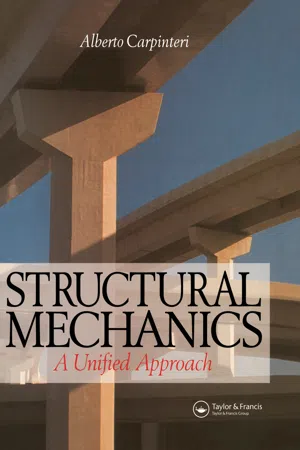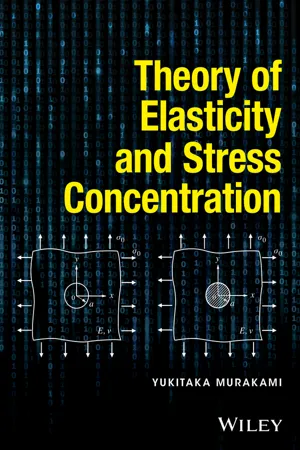Technology & Engineering
Plane Stress
Plane stress refers to a condition in which a material is subjected to stress in only two dimensions, typically in the x-y plane. This means that the stress in the third dimension (z-direction) is negligible. It is a common assumption in engineering analysis for thin structures, such as plates and shells, where the effects of stress in the thickness direction can be ignored.
Written by Perlego with AI-assistance
Related key terms
Related key terms
1 of 4
Related key terms
1 of 3
3 Key excerpts on "Plane Stress"
- eBook - ePub
Structural Mechanics
A unified approach
- Alberto Carpinteri(Author)
- 2017(Publication Date)
- CRC Press(Publisher)
19 Plane Stress and plane strain conditions 19.1 Introduction This chapter will deal with two-dimensional elastic problems in the Plane Stress condition or the plane strain condition. The Plane Stress condition has been defined in Section 7.10, in reference to a single point. The stress condition at a point is said to be plane if the stress vector belongs to the same plane independently of the cross section chosen. Likewise, the strain condition is said to be plane if the displacement vector belongs to the same plane regardless of the direction chosen. As has already been seen, a necessary and sufficient condition for a state of stress or strain to be defined as plane at a point is that one of the three principal values (of stress on the one hand and of strain on the other) should be equal to zero. Whilst it is possible for stress conditions that are plane at a point, but not globally, to exist, such as in the case of the Saint Venant solid, where the individual stress planes (Figure 9.40) for the different points of the solid are not necessarily parallel, in what follows we shall deal only with cases that are globally plane, i.e. ones having planes of stresses or strains which are all parallel. Having first introduced a mathematical method which is generally suited to the situation of plane problems and which is based on the Airy stress function, we shall consider a number of notable cases, such as the deep beam, the thick-walled cylinder, the circular hole in a plate in tension and the concentrated force acting on an elastic half-plane. The subsequent introduction of an additional method, based on the theory of complex functions of a complex variable (Muskhelishvili's Method) will make possible the treatment of the elliptical hole in a plate in tension. This latter topic will, in turn, serve as an introduction to the problems of stress concentration and of fracture mechanics which will form the subject matter of the closing chapter - eBook - ePub
- Chandrakant S. Desai, Tribikram Kundu(Authors)
- 2017(Publication Date)
- CRC Press(Publisher)
13 Two-Dimensional Stress-Deformation AnalysisIntroduction
After studying a number of one-dimensional problems and two-dimensional field problems with only one unknown or degree of freedom at a point, we are now ready to consider a different class of two-dimensional problems. This class involves analysis of stress and deformations with more than one degree of freedom at a point.Most real problems are three-dimensional. Under certain assumptions, which can depend on the geometrical and loading characteristics, it is possible to approximate many of them as two-dimensional. Such two-dimensional approximations generally involve two categories: plane deformations and bending deformations. In the case of plane deformation, we encounter subcategories such as Plane Stress, plane strain, and axisymmetric; in the case of bending, we deal with problems such as bending of plates, slabs, and pavements.Plane Deformations
Plane Stress Idealization
Figure 13.1 shows a (thin) beam and a plate subjected to loads that are applied in the plane of the structure, that is, in the x–y plane. The thickness is small compared to the x –y dimensions of the body. Such loadings are often referred to as in-plane or membrane (stretching). Under these conditions, and the assumption that the variation of stresses with respect to z , that is, across the body, is constant, it is reasonable to assume that out of the six components of stresses in a three-dimensional body1 - 3 three of them, σz ,τ zx, and τyz , can be ignored in comparison to the remaining three, σz , σy , and τxy .Figure 13.1 Plane Stress approximation: (a) Beam and (b) Plate.This idealization is called Plane Stress and involves only the following nonzero stress components,{ σ }={,}σ xσ yτx y13.1 which are functions of the coordinates x, y - eBook - ePub
- Yukitaka Murakami(Author)
- 2016(Publication Date)
- Wiley(Publisher)
6 Two Dimensional ProblemsThe solutions for two dimensional (2D) problems were developed first by closed form stress function methods, by numerical methods and recently by the finite element method (FEM). Although the closed form solutions obtained in the history of theory of elasticity are limited to relatively simple problems, learning and understanding such solutions is very important, not only for effective applications of the solutions to many practical problems but also for checking the validity of solutions obtained by numerical methods such as FEM.This chapter describes the basic solutions for a cylinder with a hole, stress concentration due to a circular hole, stress concentration due to an elliptical hole, crack problems and other basic problems. The problems of stress concentration are very important for the discussion of strength and fracture of various structures (see Part II ).In the following, we separate 2D problems into two typical cases. One is called the Plane Stress Problem and the other is called the Plane Strain Problem. These two cases correspond to the two extreme stress and strain conditions in 2D problems. If we study the characteristics of these two cases, we can understand the real cases which occur in the stress and strain conditions between Plane Stress and Plane Strain.6.1 Plane Stress and Plane Strain
6.1.1 Plane Stress
When we take an x–y coordinate within the plane of a plate and take a z axis in the direction of the plate thickness, Plane Stress is defined by the case that the stresses σx , σy and τxy are in question and other stresses are all zero. If the thickness of a plate is thin and both surfaces of the plate are free of stresses (a free surface), we may regard that the plate is in Plane Stress condition. The stress condition of a thin‐walled pressurized cylinder can be considered approximately close to a Plane Stress condition, because the internal pressure p is relatively very small compared to the axial stress σz and circumferential stress σθ
Index pages curate the most relevant extracts from our library of academic textbooks. They’ve been created using an in-house natural language model (NLM), each adding context and meaning to key research topics.
Explore more topic indexes
Explore more topic indexes
1 of 6
Explore more topic indexes
1 of 4


